Quince jelly is a quintessential British preserve. Delicious flavours of roses and apple come together in a golden pink jelly. Perfect for spreading on toasted crumpets, it’s easy to make. This quince jelly recipe tells you everything you need to know to make perfectly set jelly every time.
What are Quinces?
Quinces are close relative of the apple, being a golden coloured hard fruit that’s notable for the fuzz covering the skin. Originating from an area spreading from eastern Turkey to Afghanistan, it’s long been thought that the famous golden apple that Paris gave to Aphrodite triggering the Trojan war was a quince. They are now found all over Europe, as both an ornamental and orchard tree.
The fruit is inedible raw, and the most common use is to make quince jelly and quince cheese, or membrillo. It can also be stewed, and used like stewed apple as a topping to breakfast cereal, porridge or similar.
Why make Quince Jelly?
Quince jelly has a delicate flavour, hinting at apples and roses (the tree is a relative of both). It both looks and tastes delicious with it’s rose pink colour and subtle flavour. It’s not the easiest fruit to find in stores, so making a few jars when the fruit is in season will set you up for the year.
Also, quinces are a fruit that’s high in pectin, so it’s an easy jelly to make and get to set.
Where can I find ripe Quinces?
This can be a little tricky. The fruit is ripe in October and November in the UK, when they turn from a light yellow to a golden colour. It’s best to store them in a cool, dry place not touching each other for six weeks before using to allow them to mature.
Greengrocers may well be able to order some in when they’re ripe, or an online search for “buy quince fruit” can show suppliers.
How to Make Quince Jelly – Recipe Step-by-Step
Step one – wash and cut the quinces into chunks, about 2cm / 1″ cubes. You don’t need to core or peel them. Cut out any bad bits, but don’t worry about any speckled light brown flesh.
Step two – add quinces and the water to a large saucepan, and simmer gently until the fruit is soft. Quince are very hard so you will need to cook for some time, about half an hour.
Give cooked quince a mash with a potato masher to break them up.
Step three – strain the fruit through a jelly bag. For the clearest results, don’t poke the jelly bag! Leave it for at least 12 hours, until juice stops dripping through.
Step four – weigh the juice, and weigh out 3/4 of the weight of juice in sugar.
Step five – return the juice to a large sauce pan, add the sugar and gently heat, stirring to dissolve the sugar. Skim off any scum.
Step six – place jam jars in a baking tray and warm in an oven set to 140°C / 275°F / GM 1.
Step seven – turn up the heat to maximum to a rolling boil. Start testing for set.
There are three methods you can use to test for setting.
First, the wrinkle test. Drop a teaspoonful of the liquid onto one of your chilled plates and leave it for a few seconds. Then push the drop of jelly with your fingernail to see whether the jelly wrinkles. If it does, your quince jelly will set and can be transferred into the hot jars and sealed.
Second, temperature. The other ways to test are to watch the temperature of the boiling liquid. Keep boiling until it reaches 105°C – the setting point. You can use a jam thermometer for this; they’re easily available and not expensive.
Third, the flake test. Take a spoonful of jelly from the saucepan, and turn the spoon vertical so that the jelly runs out of the spoon. When it starts to thicken, a flake of jelly will hang from the edge of the spoon, showing that you have reached the setting point.
Step seven – Once the setting point has been reached, take the jelly off the heat.
Step eight – fill the jars. I find the best way is to use a glass jug. For the least mess, use a jam funnel. Screw on the lids – take care, as the jars will be very hot; I find a pair of nomex oven gloves perfect here. Allow the jelly to cool. As it does so, the lids will pop as the vacuum forms.
Flavour Variations
I love quince jelly. It’s simple, fuss-free and as it comes as I adore the flavour. But if you want to play with the recipe and flavours:
- Make a mix of quince and apple jelly. This will make a few quinces go much further.
- Add a kick of chilli. Just add a pinch of crushed chilli, or add a whole chilli as you cook the jelly, and remove it before jarring.
- Throw in a few scented geranium leaves as you cook the jelly, and remove before jarring.
Hints and tips for making quince jelly
- Don’t overcook the fruit, or the flavour of the final jelly will be lost. Just simmer the fruit gently.
- Never poke or squeeze the bag, as this will result in cloudy jelly.
- If your quince needs cooking but you don’t have time to make the jelly right away, then cook and strain and either keep the juice in the fridge for a few days, or freeze and make the jelly later.
- For best results, tap the jam jar as you fill it, so that any air bubbles come out. Put the lids back on the jars while still hot, to help seal them tight.
- For safety I always stand the jars in a tray when filling them in case one cracks. This has only happened to me once, but having a tray to catch any hot jelly is far safer.
- Use any plain white sugar – granulated or caster. You don’t need preserving sugar as there is plenty of pectin in quinces.
- You can reserve the fruit pulp to make membrillo – see my crab apple jelly recipe for instructions.
Quince Jelly
Ingredients
- 1.7 kg quinces
- 2 litres water
- granulated sugar (see recipe for quantities)
Instructions
- Wash the quinces, and cut into chunks - about 1" / 2.5cm cubes.
- Add the quinces and water to a saucepan, and heat until simmering. Cook for about 30 minutes, until the fruit is a soft pulp.
- Spoon the mixture into a jelly bag suspended over a bowl. Collect the juice that drains off. For the clearest results, don't poke the jelly bag!
- Weigh the juice. Weigh out 75% of the weight of juice in granulated sugar.
- Add the juice and sugar to a large saucepan - the saucepan should be less than half full. Heat gently, stirring all the time, to dissolve the sugar.
- Place the jam jars in a roasting tray in an oven set to 140°C / 275°F / GM 1
- Turn the heat up high to until the jelly is at a rolling boil
- Start to test for setting either by temperature (when jelly reaches 105°C), or by the wrinkle or flake method.
- Once the jelly has reached the setting point, remove from the heat. Fill the jam jars: I spoon the jelly into a glass jug, and then pour into the jars using a jam funnel. Close the jars with lids.
- As the jelly cools, the lids will pop showing that a proper vacuum has formed.
Notes
- Don’t overcook the fruit, or the flavour of the final jelly will be lost. Just simmer the fruit gently.
- Never poke or squeeze the bag, as this will result in cloudy jelly.
- If your quince needs cooking but you don’t have time to make the jelly right away, then cook and strain and either keep the juice in the fridge for a few days, or freeze and make the jelly later.
- For best results, tap the jam jar as you fill it, so that any air bubbles come out. Put the lids back on the jars while still hot, to help seal them tight.
- For safety I always stand the jars in a tray when filling them in case one cracks. This has only happened to me once, but having a tray to catch and hot jelly is far safer.
- Use plain white sugar – granulated or caster. You don’t need preserving sugar as there is plenty of pectin in quinces.



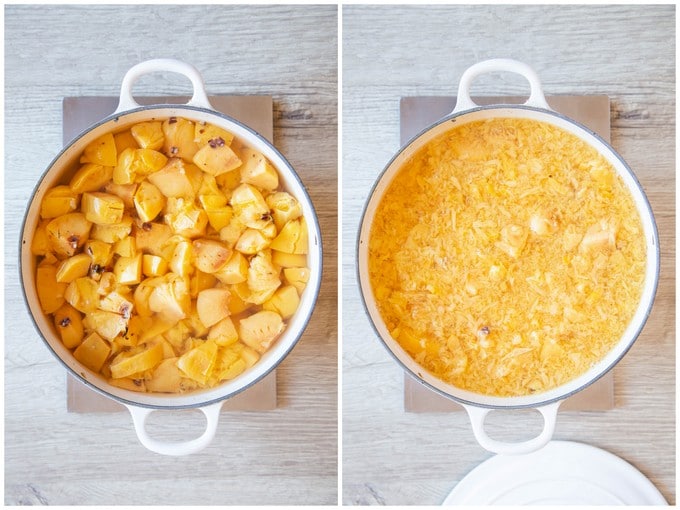


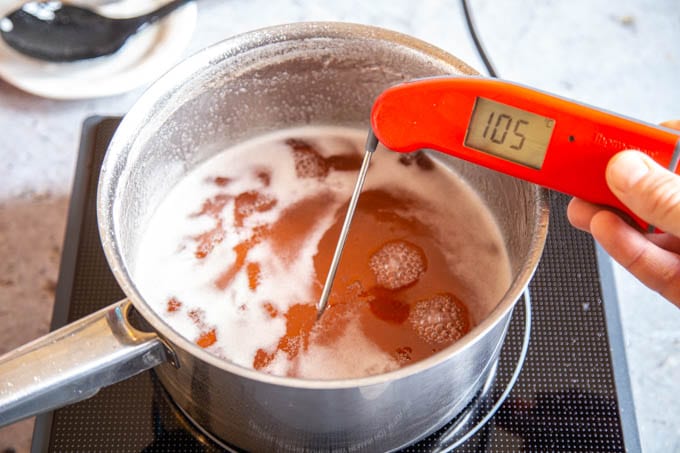

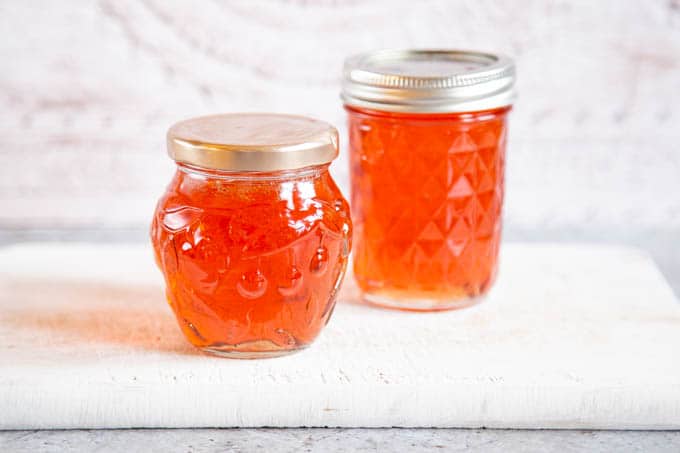

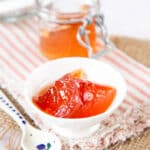



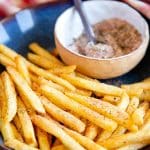
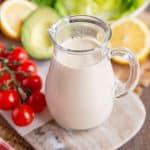

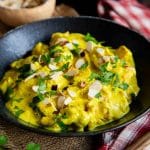




Mandy
This is a fascinating read, Helen and I can’t wait to actually try making it. I like to add small jars of preserves to my Christmas hampers for the family.
Helen
Small jars of home preservatives are perfect for gifting.
Belinda Morris
Quince jelly is one of those delicious treats that remind me of going to my Grandmother’s. So nice to be able to make it myself.
Helen
It really is a delicious treat.
Kristy D
I am over the moon to have made this and it came out perfectly. Such a beautiful color and absolutely delicious.
Helen
It is very a pretty jelly.
Victoria
Definitely a quintessential part of British tea time. Served in a jam pot, with a delicate silver spoon, to be eaten on freshly made homemade scones. Perfection. I am impatient to make some now.
Helen
That sounds like perfection.
Shelley
This was so interesting! Living here in America, I’ve never had quince jelly, but now I can’t wait to try it! And I’m so glad to have read this, so I’ll know what to do next time I find quinces in a specialty grocery (like, the importance of storing them not touching for 6 weeks so they can mature) – and I’ll know what a prize they are! This jelly is just so pretty, and such a rare treat!
Helen
I hope you are able to source some and give it a try.
Sarah Reading
Quince jelly is the kind of thing that make teatime special. Just what you want on scones with a nice cup of tea.
Helen
Perfect on scones.
connie
This jelly is delectable. I try to make a batch every year, the shop bought variety just doesn’t match.
Helen
Homemade is always better.
Gina
It’s so hard to find quince here in the states! I did once and made a crisp with them, next time this jam will be on the menu. I bet it’s delicious on so many things and I wish I had some on toast right now with my coffee :)
Helen
Perhaps try searching online, you may find someone that can provide them.
Katherine Hackworthy
I always wonder what to do with quinces. I can’t wait to try this. And that is an incredible jelly straining stand!
Helen
The adaption on what is available, it works well.
Alison
I remember enjoying Quince Jelly when I was studying abroad in Bath! This recipe was just as good if not better than the one I remembered!
Helen
So glad you enjoyed making it.
Jen
Love the idea of adding a hint of chili for a bit of a kick. These would make great gifts for friends and neighbors.
Helen
Always lovely to gift homemade goods. Perfect for Christmas presents.
Angela W
I love your preserve recipes, Helen. So easy to follow and great results. My Mother used to make this and she added geranium leaves, it was wonderful. Delighted to be able to make my own.
Helen
Geranium is a lovely addition, as long as you remember to remove the leaves before jarring!
Milly Beaufort
I can order Quince through my local greengrocer, it is worth asking. This jelly is beautiful and just perfect for a tea time treat on fresh scones.
Helen
It is definitely a good idea to ask at local greengrocers.
Denise
I can’t wait to actually make this. I currently have a stash of fruits maturing, that aren’t quite ready yet.
Helen
How wonderful, and hope you enjoy making the jelly.
Dianne Peters
We love to visit Cliveden, and the afternoon teas there are simply divine. It was the first time I had quince jelly, like this, and it was delicious. Never had anything like it. Such a good find to see your recipe and make my own. Thank you so much.
Helen
It is a lovely jelly, that quintessential part of British teatime.
Nicola
I do really enjoy that quintessential part of British teatime. Quince jelly is just fabulous and your great recipe goes to prove even novice like me can make it.
Darla
What a great read, so interesting. I wouldn’t have known what a quince was. The jelly looks beautiful and I’d really love to make this myself.
Dinah Adams
I love your jam and jelly recipes, Helen. Some great tips for a novice like me. I had never made quince jelly before, but it is so lovely. I wish I had made more now.
Kate
This jelly is like amber nectar, it is a beautiful color and tastes amazing. I highly recommend making it.
Becca
I love to make quince jelly, but it is very much a Autumn thing. They can be difficult to find, but not impossible and definitely worth all the effort.
Evie B
Quince are quite an unusual fruit. I associate them with classical still life paintings. This jelly is just lovely though and a delicious breakfast treat.
Silvana
Thank you so much for this beautiful recipe.
I absolutely love quince jelly and love sharing it with the family who appreciate the fine tastes.
Nancy Griffin
Does this need a hot water bath after pouring in jars?
Helen Best-Shaw
No, as the sugar is enough to preserve it. In the UK we dont water bath jams and jellies made with this amount of sugar as it is enough to preserve it. CErtainly a low sugar jam would need to be treated differently.